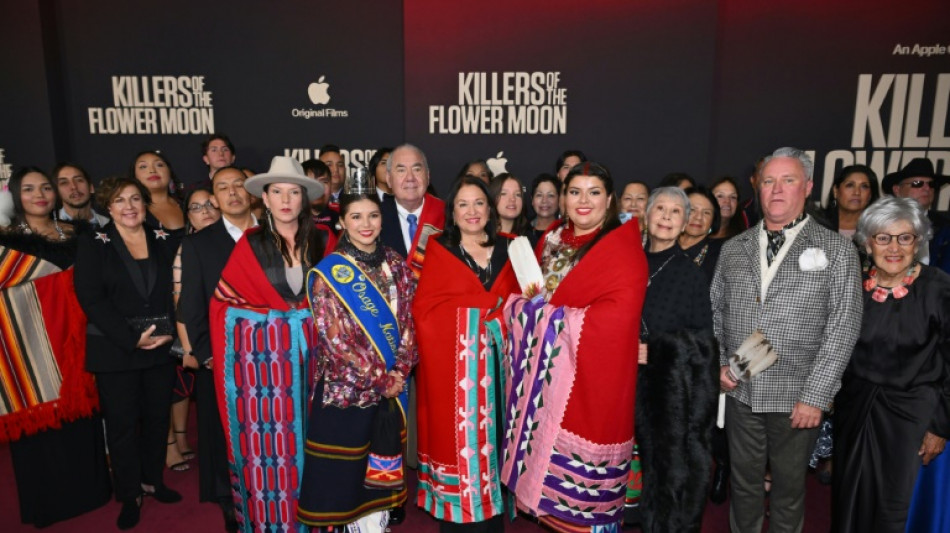
-
 Schwarz breaks World Cup duck with Alta Badia giant slalom victory
Schwarz breaks World Cup duck with Alta Badia giant slalom victory
-
Salah unaffected by Liverpool turmoil ahead of AFCON opener - Egypt coach

-
 Goggia eases her pain with World Cup super-G win as Vonn takes third
Goggia eases her pain with World Cup super-G win as Vonn takes third
-
Goggia wins World Cup super-G as Vonn takes third

-
 Cambodia says Thai border clashes displace over half a million
Cambodia says Thai border clashes displace over half a million
-
Kremlin denies three-way US-Ukraine-Russia talks in preparation

-
 Williamson says 'series by series' call on New Zealand Test future
Williamson says 'series by series' call on New Zealand Test future
-
Taiwan police rule out 'terrorism' in metro stabbing

-
 Australia falls silent, lights candles for Bondi Beach shooting victims
Australia falls silent, lights candles for Bondi Beach shooting victims
-
DR Congo's amputees bear scars of years of conflict

-
 Venison butts beef off menus at UK venues
Venison butts beef off menus at UK venues
-
Cummins, Lyon doubts for Melbourne after 'hugely satsfying' Ashes

-
 'It sucks': Stokes vows England will bounce back after losing Ashes
'It sucks': Stokes vows England will bounce back after losing Ashes
-
Australia probes security services after Bondi Beach attack

-
 West Indies need 462 to win after Conway's historic century
West Indies need 462 to win after Conway's historic century
-
Thai border clashes displace over half a million in Cambodia

-
 Australia beat England by 82 runs to win third Test and retain Ashes
Australia beat England by 82 runs to win third Test and retain Ashes
-
China's rare earths El Dorado gives strategic edge

-
 Japan footballer 'King Kazu' to play on at the age of 58
Japan footballer 'King Kazu' to play on at the age of 58
-
New Zealand's Conway joins elite club with century, double ton in same Test

-
 Australian PM orders police, intelligence review after Bondi attack
Australian PM orders police, intelligence review after Bondi attack
-
Durant shines as Rockets avenge Nuggets loss

-
 Pressure on Morocco to deliver as Africa Cup of Nations kicks off
Pressure on Morocco to deliver as Africa Cup of Nations kicks off
-
Australia remove Smith as England still need 126 to keep Ashes alive

-
 Myanmar mystics divine future after ill-augured election
Myanmar mystics divine future after ill-augured election
-
From the Andes to Darfur: Colombians lured to Sudan's killing fields

-
 Eagles win division as Commanders clash descends into brawl
Eagles win division as Commanders clash descends into brawl
-
US again seizes oil tanker off coast of Venezuela

-
 New Zealand 35-0, lead by 190, after racing through West Indies tail
New Zealand 35-0, lead by 190, after racing through West Indies tail
-
West Indies 420 all out to trail New Zealand by 155

-
 Arteta tells leaders Arsenal to 'learn' while winning
Arteta tells leaders Arsenal to 'learn' while winning
-
Honour to match idol Ronaldo's Real Madrid calendar year goal record: Mbappe

-
 Dupont helps Toulouse bounce back in Top 14 after turbulent week
Dupont helps Toulouse bounce back in Top 14 after turbulent week
-
Mbappe matches Ronaldo record as Real Madrid beat Sevilla

-
 Gyokeres ends drought to gift Arsenal top spot for Christmas
Gyokeres ends drought to gift Arsenal top spot for Christmas
-
Arsenal stay top despite Man City win, Liverpool beat nine-man Spurs

-
 US intercepts oil tanker off coast of Venezuela
US intercepts oil tanker off coast of Venezuela
-
PSG cruise past fifth-tier Fontenay in French Cup

-
 Isak injury leaves Slot counting cost of Liverpool win at Spurs
Isak injury leaves Slot counting cost of Liverpool win at Spurs
-
Juve beat Roma to close in on Serie A leaders Inter

-
 US intercepts oil tanker off coast of Venezuela: US media
US intercepts oil tanker off coast of Venezuela: US media
-
Haaland sends Man City top, Liverpool beat nine-man Spurs

-
 Epstein victims, lawmakers criticize partial release and redactions
Epstein victims, lawmakers criticize partial release and redactions
-
Leverkusen beat Leipzig to move third in Bundesliga

-
 Lakers guard Smart fined $35,000 for swearing at refs
Lakers guard Smart fined $35,000 for swearing at refs
-
Liverpool sink nine-man Spurs but Isak limps off after rare goal

-
 Guardiola urges Man City to 'improve' after dispatching West Ham
Guardiola urges Man City to 'improve' after dispatching West Ham
-
Syria monitor says US strikes killed at least five IS members

-
 Australia stops in silence for Bondi Beach shooting victims
Australia stops in silence for Bondi Beach shooting victims
-
Olympic champion Joseph helps Perpignan to first Top 14 win despite red card


Scorsese 'Flower Moon' epic based on real Native American past
Martin Scorsese's new film "Killers of the Flower Moon" recounts how the Osage nation of Native Americans gained significant oil wealth in the early 20th century and the murderous plot by outsiders to seize it.
Ahead of the movie's US release, AFP looks at the real-life story behind the film, which was adapted from US author David Grann's 2017 book of the same name.
- Who are the Osage? -
The Osage, a Native American nation which grew out of the Ohio and Mississippi River valleys, was forcibly relocated by the US government in the late 19th century westward to a reservation in what would later become the central state of Oklahoma.
As the new proprietors of the land, the nation in 1906 negotiated a rare agreement with the federal government giving Osage members exclusive mineral rights which could not be transferred or sold, only inherited.
Not long after, prospectors discovered that the Osage Reservation lied on an enormous oil reserve.
With demand for oil skyrocketing, the Osage quickly gained wealth.
In 1923 alone, according to Grann, the nation earned the equivalent of more than $400 million in today's money.
White settlers flocked to the area to take advantage of the black gold windfall.
They set up businesses, married members of the tribe or became managers of the Osage members' fortunes.
In 1921, Congress passed a racist law requiring Native Americans to have a guardian of the oil wealth appointed until they proved their "competency."
- What was the Reign of Terror? -
From 1921 to 1925, a series of murders and suspicious deaths struck the Osage Nation, who have dubbed the period the "Reign of Terror."
Mollie Kyle Burkhart's family was particularly hard-hit. Her sister Anna Kyle Brown was shot in the head in 1921, and their mother Lizzie died a few months later of suspected poisoning.
Rita Smith, another of Mollie's sisters, and husband Bill died after a bomb exploded in their home in 1923.
Their distant cousin, Henry Roan, was also found shot in the head the same year.
The Osage nation states on its website that at least 60 people were killed during this period, but that there were potentially even more murders, as some suspicious deaths were never investigated.
- Federal investigation -
With the death toll mounting, US authorities relaunched an investigation in 1925 under the auspices of the Bureau of Investigation, a forerunner of today's FBI.
After months of investigation, the federal officials uncovered an intra-family plot.
Burkhart's husband Ernest, a white settler, and his uncle William Hale, a wealthy white rancher, had orchestrated the murders in order to take control of their oil rights.
Ernest Burkhart and Hale, after attempting to cover up the crimes, were convicted of murder and received life sentences in 1926 and 1929.
Grann alleges in his book that other murders, which went without convictions due to a lack of evidence, are almost all attributed to people from outside the nation seeking to seize Osage oil rights.
- Today -
Around a quarter of the shares of the reservation's oil rights are held today by non-Osages. Most of the oil has since dried up, however, and royalty checks now amount to only a few thousand dollars.
The Osage Nation is nonetheless pushing for federal legislation that would allow the non-Osages' shares to be gifted or sold back to the nation.
The murders of the 1920s left an indelible mark on the memory of the Osage community, which was heavily involved in the making of Scorsese's film.
Alongside stars Leonardo DiCaprio and Robert De Niro, the film features Osage actors, props made by Osage craftworkers and involved work with Osage language experts.
A.Jones--AMWN



